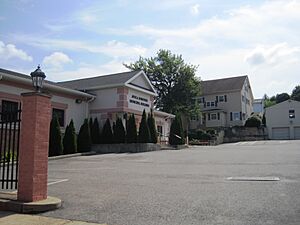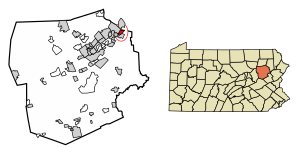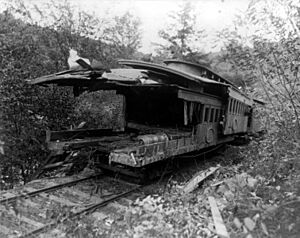Avoca, Pennsylvania facts for kids
Quick facts for kids
Avoca, Pennsylvania
|
|
|---|---|
|
Borough
|
|

Municipal Building
|
|

Location of Avoca in Luzerne County, Pennsylvania
|
|
| Country | United States |
| State | Pennsylvania |
| County | Luzerne |
| Region | Greater Pittston |
| Incorporated | 1871 |
| Government | |
| • Type | Mayor–council |
| Area | |
| • Total | 1.02 sq mi (2.64 km2) |
| • Land | 1.02 sq mi (2.64 km2) |
| • Water | 0.00 sq mi (0.00 km2) |
| Elevation | 735 ft (224 m) |
| Population
(2020)
|
|
| • Total | 2,507 |
| • Density | 2,457.84/sq mi (948.62/km2) |
| Time zone | UTC-5 (Eastern (EST)) |
| • Summer (DST) | UTC-4 (EDT) |
| Zip Code |
18641
|
| Area code(s) | 570 |
| FIPS code | 42-03640 |
Avoca is a small town, also called a borough, in Luzerne County, Pennsylvania, United States. It's part of the Greater Pittston area.
Avoca is about 7.5 miles (12 km) northeast of Wilkes Barre. It is also about 3.4 miles (5.5 km) southwest of Scranton. In 2020, about 2,501 people lived there. The Wilkes-Barre/Scranton International Airport is right next to Avoca on its eastern side.
Contents
History of Avoca
Avoca became an official borough in 1871. A borough is like a small, self-governing town. Its first name was "Pleasant Valley."
In 1887, the town's name changed to "Avoca." This was because another place in Pennsylvania already used the name "Pleasant Valley." The new name came from a place called Avoca, County Wicklow in Ireland.
Major Events in Avoca's Past
A sad event happened in 1888 called the Mud Run Disaster. This was a terrible train wreck. Most of the 64 people who died in this accident were from Avoca.
From 1945 to 1947, the Wilkes-Barre/Scranton International Airport was built. A small part of the airport is in Avoca. Most of it is in the nearby Pittston Township.
For many years, coal mining was the main job in Avoca. But after the Knox Mine Disaster in 1959, the coal mining industry in the area almost disappeared.
Geography of Avoca
Avoca is a small area of land. According to the U.S. Census Bureau, the borough covers about 0.9 square miles (2.3 square kilometers). All of this area is land.
The students in Avoca go to schools in the Pittston Area School District.
Population Changes in Avoca
| Historical population | |||
|---|---|---|---|
| Census | Pop. | %± | |
| 1880 | 1,913 | — | |
| 1890 | 3,031 | 58.4% | |
| 1900 | 3,487 | 15.0% | |
| 1910 | 4,684 | 34.3% | |
| 1920 | 4,950 | 5.7% | |
| 1930 | 4,943 | −0.1% | |
| 1940 | 4,771 | −3.5% | |
| 1950 | 4,040 | −15.3% | |
| 1960 | 3,562 | −11.8% | |
| 1970 | 3,543 | −0.5% | |
| 1980 | 3,536 | −0.2% | |
| 1990 | 2,897 | −18.1% | |
| 2000 | 2,851 | −1.6% | |
| 2010 | 2,661 | −6.7% | |
| 2020 | 2,501 | −6.0% | |
| 2021 (est.) | 2,506 | −5.8% | |
| Sources: | |||
In the year 2000, there were 2,851 people living in Avoca. There were 1,177 households, which are groups of people living together.
The population of Avoca was highest in 1920, with 4,950 residents. Since the 1930s, the number of people living in Avoca has slowly gone down. By 2017, the population was about 2,630.
Education in Avoca
Students in Avoca attend schools that are part of the Pittston Area School District.
Notable People from Avoca
- Michael B. Carroll, a member of the Pennsylvania House of Representatives
- Jack Harding, a former head football coach for the University of Miami team
See also
 In Spanish: Avoca (Pensilvania) para niños
In Spanish: Avoca (Pensilvania) para niños




